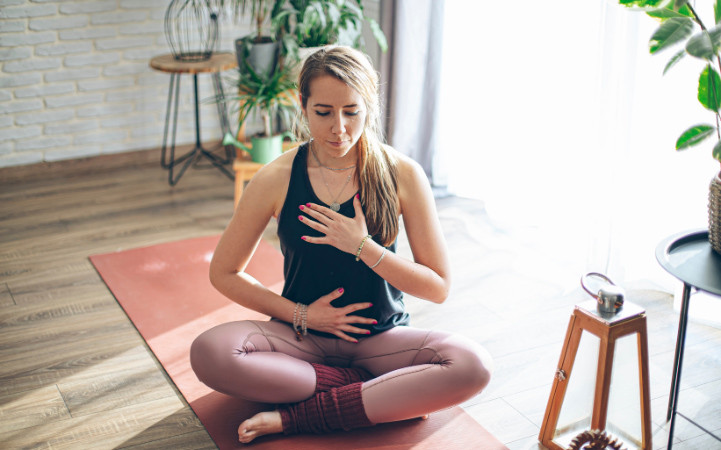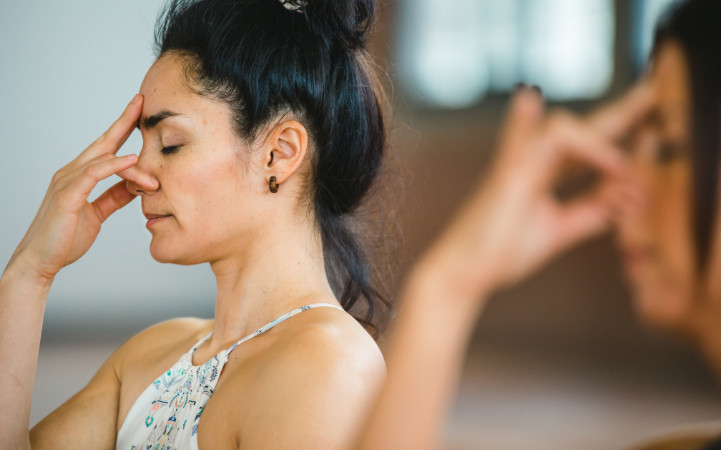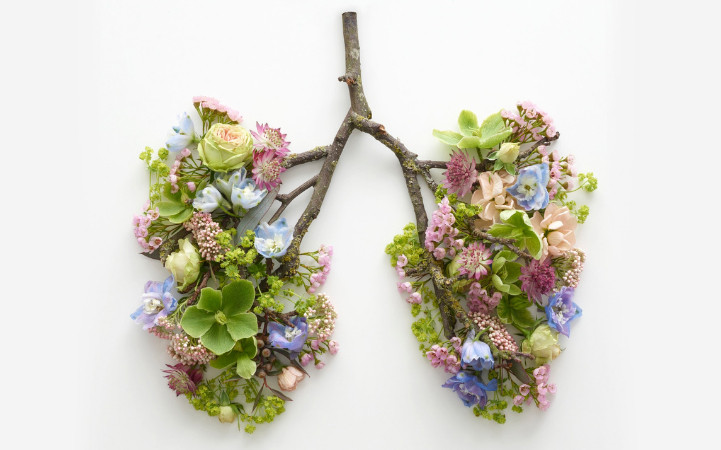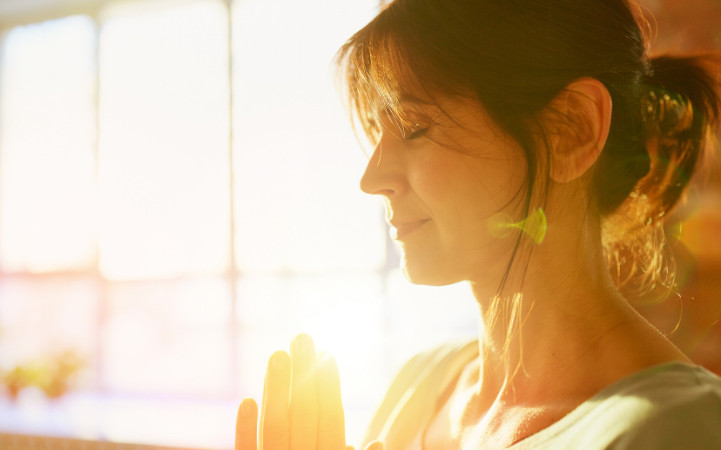Read our guide to understand the world of pranayama, plus how to practice five yoga breathing exercises you can learn today.
Modern living takes a toll on us all. We need easy, effective ways to recharge and detox our whole system. The secret to both lies in your breath.
Yogic breathing exercises, also known as pranayama, are easy to practice and offer a host of benefits! Read on to understand this amazing world of pranayama, as well as learn five techniques you can use starting today!
Topics covered:
- What is prana?
- What is pranayama?
- Benefits of pranayama (breathing exercises)
- Is pranayama practice effective in emotion regulation?
- Five pranayama techniques to try today
- Beyond pranayama
- SKY Breath Meditation (Sudarshan Kriya) in headlines
- Go deeper into breathing practices at an in-person or online course with us
What is prana?

According to yoga, prana is the life energy that separates the living from the dead. The subtle life force energy, also known as chi, flows through subtle energy channels called 'nadis' and energy centers called 'chakras.'
Our body needs prana for both our physical and subtle layers of existence. Without prana, our body cannot survive. It helps keep us alive.
Prana has many levels of understanding, from the physical breath to the energy of consciousness to kundalini shakti to the original creative power. Yogis say that the entire universe is a manifestation of prana. 🤯
Sources of prana

You can increase your prana level by focusing on four main areas: food, rest, breath, and mindset.
There is more prana in fresh foods than canned, frozen, or leftover foods. Plant-based food is considered to have higher prana.
The amount and quality of sleep have an effect on our prana levels. And so does our meditation practice because of the deep rest gained. However, the most direct and immediate source of prana is breath.
When the prana level is high and flows smoothly, the mind becomes calm, happy, positive, and enthusiastic. Low prana levels lead to more worry, fear, uncertainty, conflict, tension, depression, doubts, and other negative feelings.
And, as we will see in a moment, the way we breathe has a powerful effect on our mindset.
The effects of low and high prana

If certain foods and activities can affect our subtle life energy, then how we feel moment to moment and day to day is within our control.
When we are feeling dull and lethargic or negative emotions are playing havoc in our lives, we can increase our prana levels and overcome these challenges. Otherwise, low prana can perpetuate negative aspects in our lives.
More fresh food, better sleep, meditation, and regular pranayama practice can increase our prana levels and put the quality of our lives back into our own hands. Pranayama is certainly one of the easiest ways to enjoy higher levels of prana.
What is pranayama?

The word pranayama is in Sanskrit and describes breathing exercises in yoga.
These exercises can boost our energy, reduce stress, enhance mental clarity, and improve physical health. In the West, many people are using the term 'breathwork' to describe yoga breathing exercises or pranayama.
We already know that ‘prana’ refers to the subtle, universal life force. The second half of the word, ‘ayama,’ means to regulate, control, or lengthen.
Pranayama is more than just controlling your breath. It's about increasing prana using your breath. These techniques typically involve breathing through the nostrils in a specific pattern of inhalation, breath retention, and exhalation.
When done correctly, pranayama brings harmony to the body, mind, and spirit. It makes you stronger physically, mentally, and spiritually.
Some of the more well-known breathing exercises are Ujjayi breathing (ocean breath), Bhastrika pranayama (bellow’s breath), and Bhramari pranayama (bee breath). Another popular pranayama is Nadi Shodhan (alternate nostril breathing). You can find videos to learn these breathing exercises below.
Also worth noting, The Art of Living teaches many pranayama exercises through their courses and retreats in a clear and simple way.
Benefits of pranayama (breathing exercise)

Practicing pranayama techniques offers many benefits; here are a few:
- Calms the mind, reducing worries and anxieties
- Improves focus and attention, removing brain fog
- Increases energy, bringing enthusiasm and positivity
- Boosts the immune system
- Rejuvenates the body and mind
- It may even slow down the aging process
- Boosts creativity
- Improved lung function
- Helps with craving and withdrawal symptoms related to addiction
Is a pranayama practice effective for emotion regulation?

Gurudev Sri Sri Ravi Shankar, founder of the Art of Living Foundation, spoke at a conference in Germany. He explained how our breath is connected to our emotions.
“Our breath is linked to our emotions. For every emotion, there is a particular rhythm in the breath. So, while you cannot directly harness your emotions, with the help of breath, you can do that.
By understanding our breath's rhythm, we control our minds and conquer negative emotions like anger, jealousy, and greed. Furthermore, we can genuinely smile from our heart.”
The science of breath

In 2018, a study found that deep breathing can improve our emotions and well-being. When you breathe in slowly through your nose, it activates the parasympathetic nervous system. This leads to positive changes. The benefits include feeling more comfortable, relaxed, and alert. It can also reduce anxiety and depression.
Another study in 2002 found that copying different breathing patterns can make us feel angry, sad, or happy.
Pranayama works on these very principles. By controlling our breath, we can change our emotions instead of letting them control us.
Science continues to validate yogic breathing techniques like SKY Breath Meditation. In 2020, a study showed that university students had an improved response to stress.
Five pranayama techniques to try today
You can practice these yogic breathing exercises at any time of the day, preferably on an empty stomach.
Humming Bee Breath (Bhramari pranayama)
Is your mind buzzing with activity? Can't stop thinking about what someone said to you? Find a peaceful spot. Practice the Humming Bee Breath to calm your busy mind. In this, you inhale deeply and then make a humming sound as you exhale. This breathing technique is especially useful for those with hypertension or suffering from insomnia.
Watch this video to learn how to do this amazing yoga pranayama on your own.
Shining Skull Breath (Kapalbhati pranayama)
Skull Shining Breath is considered the most effective for detoxifying the body and clearing the energy channels. Additionally, it is believed to increase one’s intuition and facilitate natural weight loss. In this, you inhale passively and exhale actively and forcefully. Avoid practicing at night. * see contraindications
Watch this video for instructions on how to practice shining skull breath.
Bellows Breath (Bhastrika pranayama)
Low energy levels? Doing three rounds of bellows breath boosts your energy and calms your mind. Think “yogic cappuccino”! Avoid practicing at night unless you’re planning to stay up late. * See contraindications
Watch this video for an easy demonstration of this powerful deep breathing exercise.
Ocean Breath (Ujjayi pranayama)
Ocean breath is also known as victorious breath because it is victorious in managing too many thoughts. In this, we create a snore-like sound in the throat as we inhale and slowly exhale. Many use victorious breath during their asana practice (physical postures).
Watch this brief video to start practicing ocean breathing today.
Alternate Nostril Breathing (Nadi Shodhan pranayama)
Can't concentrate on the task at hand? Do five to nine rounds of alternate nostril breathing (ANB). You breathe in and out through one nostril at a time, following a specific pattern. After that, you can do a brief guided meditation for even more clarity and focus.
Considered one of the most important pranayamas, this slow pranayama helps calm and center the mind. It harmonizes the left and right hemispheres of the brain, which are related to our logical and emotional sides. By breathing through alternate nostrils in this specific pattern, we can balance both brain hemispheres. ANB is a yogi's go-to for its instant calming effect and meditation prep.
Watch this video to learn how to practice alternate nostril breathing on your own.
* Contraindications
Avoid practicing bellows breath or shining skull breath if you have any of the following conditions:
- Pregnancy
- High blood pressure (uncontrolled by medication)
- Serious heart problems
- Recent major surgery
- Glaucoma or other conditions of increased eye pressure
Beyond pranayama
Even deeper than practicing pranayama is Sudarshan Kriya, also known as SKY Breath Meditation. Gurudev Sri Sri Ravi Shankar, the founder of the Art of Living, created Sudarshan Kriya in the early 1980s. This breathing technique has been researched and proven to have significant benefits for the mind and body.
Over 65 independent studies have found the following benefits:
- 33% increase in immune cell count
- 78% reduction in serum cortisol levels (stress hormone)
- Significant decrease in clinical/non-clinical depression and anxiety
- Healthier blood pressure
- Enhanced deep sleep
- Greater mental focus
- Reduced PTSD symptoms
- Reduced addictive behaviors
- Improved lung capacity
- 21% increase in life satisfaction
SKY Breath Meditation (Sudarshan Kriya) in headlines
- Prevention Magazine calls Sudarshan Kriya “The Easy Breathing Technique That Can Lower Your Anxiety 44%”, highlighting how in the same study, "many people reported better sleep, improved self-awareness, and even fewer PMS symptoms."
- Psychology Today described the Art of Living's signature technique Sudarshan Kriya, as "An Incredible Alternative to Mindfulness You Never Heard Of", saying it “can help those of us who can’t be inactive because it is an active meditation.”
- Harvard Health Publications says it "shows promise in providing relief for depression."
- Vogue declares: “Breathing is the New Yoga!” explaining “Sudarshan Kriya’s engagement of the parasympathetic nervous system can rebalance brain chemistry.”
- Considering “Yogic Breathing: What are the benefits?” Shape magazine notes that "Sudarshan Kriya] not only aims to remove day-to-day stresses but also target negative emotions you may not know are still affecting you."
- Yoga Journal says it "may be the fastest growing spiritual practice on the planet," as millions of people have enjoyed this technique in over 150 countries.
- CNN says, “The simple act of breathing turns from life-sustaining to life-changing.”
- Yale News reports that students' mental health improves with SKY Breath Meditation.
- Popsugar, If Mindfulness Practices Make You Anxious, Try SKY Breath Meditation
- Style Magazine declares: The Art of Living Foundation: A Breath of Fresh Air
Go deeper into breathing practices at an in-person or online course with us
You can learn many pranayama breathing exercises, yoga asanas, and the SKY Breath Meditation in The Art of Living's Part 1 course. Whether you choose an in-person course or an online course from the comfort of your own home, the Art of Living Part 1 course will have you well established on your pranayama journey. Register today and start enjoying all the benefits you’re looking for.
